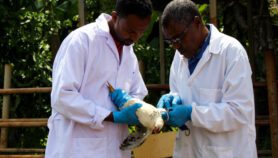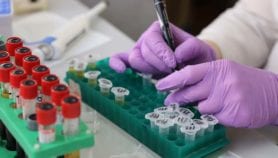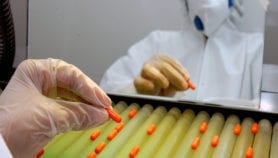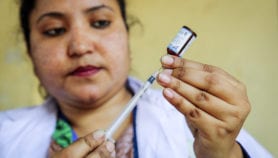Send to a friend
The details you provide on this page will not be used to send unsolicited email, and will not be sold to a 3rd party. See privacy policy.
Historically, intellectual property rights (IPRs) and plant breeding have had nothing to do with each other. In Asia and much of the South, ethics, colonial legacies, and the threat that statutory monopolies in the health and food sectors pose to peoples’ basic needs, meant that patents were never allowed on life forms.
Until recently, industrialised countries also excluded living organisms from intellectual property (IP) regimes. Unlike manufactured products, biological material was considered the realm of nature and therefore as a “discovery”, not an invention. With the dawn of the hybrid seed industry, however, and later the biotechnology-driven life sciences industry, plant breeding has become big business and those businesses want exclusive rights to their research results.
Today, with the breeding sector dominated by a few mega-corporations, patents on plants and livestock — and draconian restrictions on farmers — are the norm in most industrialised nations. So far, Asia has followed a different path. But it appears increasingly likely that it will meet the same end.
In Asia, the foundation for the emergence of IPRs on life was laid by the Green Revolution of the 1960s and 1970s when a package of credit, chemicals and — most importantly — high-input responsive semi-dwarf varieties of staple crops, such as rice and wheat, were introduced to the region’s farms.
The Green Revolution engineered the framework for the private sector’s entry into Asia’s agricultural sector. It established dependency on external seeds — the basis for a private seed market. As Green Revolution seeds stormed through the rural areas, Asia lost much of its abundant crop diversity.
The seed industry is now stepping in for its piece of the pay-off. In the eyes of most corporations, the Asian seed market is vastly under-penetrated. Asia consumes a third of the world’s agricultural seed — nearly 40 million tons a year. But it accounts for less than a quarter of the $32 billion annual commercial seed market.
By and large, Asia’s seed supply still remains the domain of farmers and the public sector. Farmers in India are responsible for at least 60 per cent of the annual seed supply, while farmers in the Philippines produce 80 per cent. But this situation is fast changing.
The private sector stepped into Asia’s seed supply in the 1980s when World Bank and US-supported seed programs and hybridisation of new crops converged. F1 hybrids give high yields, but lose this advantage the following generation, so farmers have to buy new seed regularly. Hybrids now exist for maize, rice, pigeonpea, millets, sorghum, oilseed rape, sunflower and many vegetable crops.
Hybrids are a crucial piece of the privatisation puzzle. But it is primarily the advent of genetic engineering that is behind the industrial sector’s surging interest in the Asian seed market and its demands for intellectual property protection. Industry analysts estimate that biotech will add 50 per cent to the value of seed markets, making previously unprofitable markets, such as rice, profitable.
A significant financial attraction of biotech is the opportunity it provides for companies to claim ownership of innovation. Whereas conventional breeding relies on natural modes of reproduction, genetic engineering violates natural processes of reproduction by transferring foreign strands of DNA from one organism to another, even across species barriers.
The processes of genetic engineering — as well as the genes themselves and the end product, such as a plant variety — are generally regarded as “new constructs” of human intervention, and therefore intellectual property. Seed companies can use various mechanisms to protect such property, including plant variety protection, material transfer agreements and, more frequently, patents.
Until recently, patents on living organisms were not recognised. This has begun to change. On January 1, 1995 the Agreement on Trade-Related Aspects of Intellectual Property Rights (TRIPS) entered into force, obliging all parties to make patents available for any invention, whether product or process, in any field of technology without discrimination by the year 2000 for developing countries and 2006 for least-developed countries.
However TRIPS Article 27.3(b) allows World Trade Organisation (WTO) members to exclude “plants and animals other than micro-organisms and essentially biological processes”, provided that they offer patents or establish “an effective sui generis system” of protection for plant varieties. What constitutes “an effective sui generis system” is not defined by WTO. This has generated considerable debate — as well as delay in the implementation of TRIPS in developing countries.
In Asia, the seed industry and its allies have aggressively promoted the Union for the Protection of New Varieties of Plants (UPOV) as the appropriate system of sui generis protection. UPOV is a small intergovernmental organization that administers common rules for the recognition and protection of plant variety protection (PVP) internationally. Most of the 46 UPOV members are industrialised countries, which currently operate the UPOV Convention of 1978 or 1991.
Although PVP was originally instituted as an alternative to patenting, successive revisions of the convention have meant that the rights granted to breeders have become increasingly similar to those granted under the patent system. While breeders get exclusive commercial control over the reproductive material of their varieties and the right to enforce licenses, farmers planting PVP-protected varieties are prohibited from saving seeds for replanting except under highly restricted conditions. And increasingly in many countries practicing PVP, the right of the breeder extends to the farmers’ harvest and the direct products of that harvest.
Asia is now fast conforming to the principles of UPOV. The speed and timing of this process is related to the need to comply with TRIPS and provide some sui generis form of protection over plant varieties in countries that wish to avoid the patent route. But it is also part of a deeper and more fundamental trend; industry’s push to privatise resources and knowledge within the restructuring of global markets.
Numerous Asian countries have taken the sui generis option seriously and sought to guarantee their huge farming populations special features to buffer the impact of PVP. Others try to ensure that some of the royalties captured by industry will flow back into genetic conservation. Thailand, for instance, has created provisions for local communities to secure rights over local varieties, compulsory sharing of profits from PVP-protected seeds and links to biosafety law. Similar thinking has been guiding the drafting process in Bangladesh.
However, the overriding trend is not toward a world of do-as-you-please sui generis systems. It is toward harmonisation. This is what we now see throughout the region. For example, India and the Philippines both started off with somewhat “progressive” PVP drafts, seeking to avoid the worst of UPOV in the implementation of TRIPS. As those drafts moved further through the legislative pipeline, nearly all those special features were deleted or watered down considerably, so that these countries are now about to adopt unmistakably UPOV laws.
In the next few years, enormous pressure will be placed on Asian countries to take further steps to complete the legislative processes and tighten the laws in favour of corporate breeders. This is the experience of every single country where PVP has been introduced.
The pressure on Asian countries that adopt PVP systems based on UPOV to accede to further demands of global industry will only grow. Indeed UPOV itself, which is dedicated to strengthening the rights of corporate breeders, is another actor that will continue to use all its weight to lobby Asian governments to conform to its Convention.
As UPOV’s former Vice Secretary-General recently put it, “Countries have a great deal of freedom in devising their own laws on genetic resources and farmers’ rights and so on, as long as the new laws do not conflict with UPOV requirements”. In sum, many forces are now converging to ensure uniform intellectual property rights over farm biodiversity in Asia.
This article is extracted from ‘Intellectual Property Rights: Ultimate control of agricultural R&D in Asia’ (March 2001).
Link to full text













